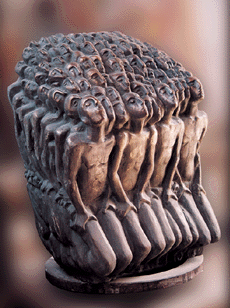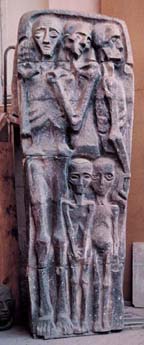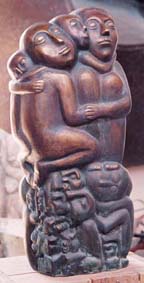|

Summer
1999 (7.2)
Fazil Najafov
(1935- )
The Expressive
Magnificence of Stone
  The haunting images
found in Fazil Najafov's Sculpture Garden invite you to speculate
on their ambiguous meanings. For example, his bronze sculpture
"Three Blind Men" (1979) shows three men clutching
onto each other, struggling to remain standing. Two of them stare
blankly up into the sky, oblivious to the sun above them. The haunting images
found in Fazil Najafov's Sculpture Garden invite you to speculate
on their ambiguous meanings. For example, his bronze sculpture
"Three Blind Men" (1979) shows three men clutching
onto each other, struggling to remain standing. Two of them stare
blankly up into the sky, oblivious to the sun above them.
The emphasis here is not on realistic detail-their clothing,
hair or anatomical correctness-is unimportant. Instead, Fazil
seems to be revealing something more symbolic.
Perhaps, it was the crippling blindness of living under a repressive
Soviet government (that would collapse 12 years later) or could
it imply the blind aspiration of our generation busily scurrying
about not knowing the direction of their own destination?
Fazil says that he based the sculpture on childhood memories
of blind men who used to wander along the streets praying. He
refers to this sculpture as one of his more "pessimistic
and sensitive" works.
In April 1999, we asked Fazil about what it was like struggling
to maintain his artistic vision, especially when confronted by
a Soviet government that strongly disapproved of such ominous
abstract images
_____
 Fazil
Najafov was an extraordinary student at the Surikov Art Fazil
Najafov was an extraordinary student at the Surikov Art  Institute
in Moscow. For his final art project in 1961, he decided to create
a work specific to Azerbaijan, something that reflected the life
of the oil workers in his country. His clay sculpture depicted
an exhausted oil worker leaning his tired body against a steel
pipeline. The inspiration for the sculpture had come from Fazil's
visit to Oil Rocks, where he witnessed the difficult conditions
under which the oil workers lived and worked. At that time, this
small town built up over the Caspian on wooden piers was hardly
ten years old. Oil Rocks was the first experiment by the oil
industry for drilling offshore for oil, not only in Azerbaijan
but in the entire world. Institute
in Moscow. For his final art project in 1961, he decided to create
a work specific to Azerbaijan, something that reflected the life
of the oil workers in his country. His clay sculpture depicted
an exhausted oil worker leaning his tired body against a steel
pipeline. The inspiration for the sculpture had come from Fazil's
visit to Oil Rocks, where he witnessed the difficult conditions
under which the oil workers lived and worked. At that time, this
small town built up over the Caspian on wooden piers was hardly
ten years old. Oil Rocks was the first experiment by the oil
industry for drilling offshore for oil, not only in Azerbaijan
but in the entire world.
When Fazil turned in his project, the authorities deemed it unacceptable
and "unprofessional". What they meant was that it was
too controversial - Soviet workers weren't supposed to look fatigued.
Labor was to be glorified, workers to be romanticized. The authorities
thought that Fazil's tired workers looked more like convicts
than contented workers.
Right: Fazil Najafov, "Morning",
2x1x1m, stone, 1983.
He was ordered to destroy the sculpture and submit a different
work. He refused. They threatened him by saying that he wouldn't
receive his university degree, but Fazil wouldn't budge. They
gave him another chance to submit a different project, this time
suggesting that he create a small statue of a Pioneer (youth
group of the Communist party). They even offered him 2,500 rubles
for it. Fazil still turned them down and returned to Baku without
his degree.
The Purpose of
Art
This
kind of treatment was typical for artists during Soviet rule.
Art was to be created for propagandizing the government's goals.
Many of Fazil's professors who disagreed with this concept were
fired. Fazil himself disagreed with the government's restrictions.
He recalls, "When we read in books and heard from others
about art from democratic republics, we saw that the purpose
of art was far different from what we had been taught."
  Fazil
came up against similar objections when he submitted a work for
an exhibition commemorating World War II which was held in Moscow
in 1965. Again, his work was rejected for being too "pessimistic". Fazil
came up against similar objections when he submitted a work for
an exhibition commemorating World War II which was held in Moscow
in 1965. Again, his work was rejected for being too "pessimistic".
Left:
Fazil Najafov,
"Echo of an Epoch," 85x65x45cm, bronze, 1979.
Even though it had been praised in Azerbaijan, the Russian generals
on the committee of the Moscow exhibition objected, saying that
it would be a shame to exhibit such a work, since the Soviet
Union had been victorious in the war.
At that time, Soviet art was supposed to reflect only one kind
of "ism" - Social Realism. All other "isms"
- Impressionism, Expressionism, Surrealism and Modernism - were
held under suspicion and considered dangerous - like a ticking
bomb ready to go off at any time.
Artists who were willing to promote Communist ideology were courted
by the Soviet regime. Those who chose to erect monuments to past
and present Soviet leaders received awards and privileges, were
offered studios and honorariums and were assigned government
contracts. Accordingly, most artists chose to submit to the government's
mandates.
Exhibitions were planned around political themes, such as "We
Are Building Socialism," "Labor and Human Beings,"
"Lenin's Anniversary" - commemorating his 70th Jubilee
(date of birth), then his 80th, 90th and 100th. No artist could
stray far from the given theme and still expect to place his
work in the exhibition.
  "Real" Artists "Real" Artists
In Azerbaijan,
however, the pressure on artists to conform was not as severe
as it was in Moscow. Since the professional level was lower,
according to Fazil, and there were fewer artists, it was easier
for him to make a name for himself as an artist despite not having
the government's blessing.
Fazil says that the Soviet regime influenced the great majority
of Azerbaijani artists; only a few managed to create what he
would identify as "real art".
This alternate group of artists included such outstanding artists
as Fuad Abdurrahmanov, Javad Mirjavad and his brother Tofig Javadov
along with their cousin Rasim Babayev. Artists from the following
generation included Kamal Ahmad, Husein Hagverdiyev and Ujal
Hagverdiyev.
Left: Fazil Najafov, "Commemoration of
Victims of World War II, 25 years later," 3x1x1m, 1965.
As a rule, these artists were less respected and less popular
and often passed over, instead of recognized. Many of these "underground"
artists were not granted university diplomas, another deterrent
that held them back professionally.
Without his diploma but still determined to be an artist, Fazil
returned to Baku after his confrontation at the Art Institute.
He took part in various exhibitions and joined the USSR Artists'
Union. In 1969, he was allocated the studio space where he still
works today.
Recalling what it was like to make a name for himself in Baku,
Fazil says, "Though I was young, I was esteemed among the
professional artists. No matter what exhibition I offered my
works, they accepted them. Sometimes my works were even sent
to Moscow, which was considered very prestigious at the time."
Abstract Motifs
One
of Fazil's first official assignments in Baku, a commission by
architect Yusif Gadimov, was the copperwork on the outside walls
of the House of Actors (1970). "The concept of this work
is intellectual since the House of Actors is an institution of
intellectual and thinking people," says Fazil. "There
were different motifs and forms in the work. I tried to express
something with movement and pantomime. I wanted to symbolize
these things."
Apparently, Baku's art officials didn't understand Fazil's symbolism.
After the sculpture was erected, he was attacked for being "formalistic".
The sculpture was promptly removed and Fazil had to write an
"explanation" of what he had done. He was essentially
blacklisted and accused in speeches by high-ranking officials.
Fazil spent many of the following years in disgrace; even his
close friends avoided him. Later, at the Tbilisi Biennial Art
Exhibition in 1986, he was awarded the Grand Prize for being
the "Most Disgraced of the Most Talented Artists."
Fazil got into trouble because Soviet art was supposed to use
realistic forms, not symbolic ones. Artists who added abstract
notions to their works ran the risk of being considered "anti-Soviet".
For instance, one of Fazil's bronzes entitled "Stories of
Life" (1987) holds controversial layers of meaning that
may not be so obvious at first glance. The sculpture depicts
two themes: on the top level, he depicts family members all smiling,
content and lovingly embracing each other. The lower part of
the sculpture reveals hidden, grotesque faces and relationships
that are never exposed to the world. The work depicts a family,
but could it not also represent larger institutions and nations?
 Soviet
Legacy Soviet
Legacy
The constraints imposed by the Soviet government on artists have
been far-reaching. It's true that during the Soviet period, many
individuals did get the chance to study and pursue careers in
art. Today there are more than 800 sculptors and painters in
Baku but few among them, according to Fazil, are "real"
artists. "Without contracts from the government, most Azerbaijani
artists have no means of support. In the past they were used
to fulfilling the orders that they were assigned, but many of
them don't know how to do anything besides that. The human initiative
and creativity that Soviet system snuffed out has been slow to
reemerge," Fazil observes.
Right:
Fazil Najafov,
"Stories of Life", bronze, 1987. Happiness is exposed
to the public; misery is hidden.
"For artists in Azerbaijan today, it's as if an army general
commanded his soldiers to take off their heavy shoulder straps
and cumbersome waist belts and begin to move about freely. It's
as if he told them: 'Go and do what you are able to do,'"
says Fazil. "If you're an artist capable of doing something,
if you're someone who really comprehends what art is all about,
you'll be able to achieve something. Those who can't are in an
awkward situation. Unfortunately, in the meantime, many artists
have succumbed to the whims of commercialization to satisfy the
wishes of potential customers-not all artists, of course. There
are still those who create real art."
Despite these current economic difficulties, Fazil says that
he prefers the current situation. He has managed to sell some
of his works to foreigners, but admits that he doesn't earn any
more money today than he did prior to independence. "The
difference is that now we have the freedom to work and create
as we want to. Now we can express our thoughts freely."
With an eye to the future, Fazil concentrates on his favorite
medium-stone. "I have always been sensitive to stone. It
seems that I understand the nature of stone and, in turn, it
understands me, too. Stone retains the memory of millions of
years, guarding the secrets of time deep inside it. With stone
you can create something monumental, something eternal; you're
not dealing with cardboard. In a single word, I love stone. I
like bronze, too, but nothing attracts me as much as the expressive
monumental silence of stone."
For more photos
of Fazil's sculptures, see "Fazil Najafov: Frozen
Images of Transition" [AI 3.1, Spring 1995]. His studio
is located at Ashug Juma Street, 851/52. Home Tel: (99-412) 61-53-49;
Studio: 66-71-09; Fax: 93-12-76.
From Azerbaijan
International
(7.2) Summer 1999.
© Azerbaijan International 1999. All rights reserved.
Fazil | AZgallery
Artists
|


 Fazil
Najafov was an extraordinary student at the Surikov Art
Fazil
Najafov was an extraordinary student at the Surikov Art 

 Soviet
Legacy
Soviet
Legacy